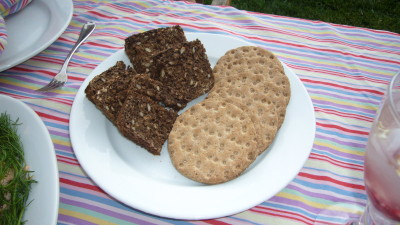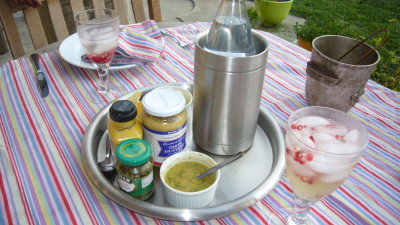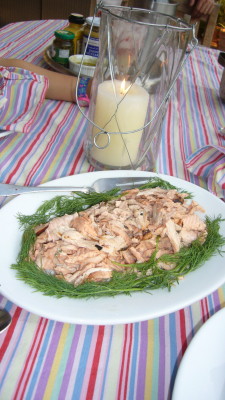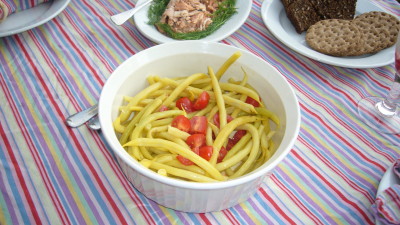by Lisa
Just about everything we eat is seasonal–including all of our produce and much of our meat as well. Which basically means that if the produce, meat, fish, and sometimes even eggs are not at our farmers market, we don’t eat it. We’re incredibly fortunate that our market runs year round, which ensures that the majority of our diet is local, too. I don’t buy strawberries in the winter, or apples in the summer, or lamb in the fall. I refuse to buy an apple in July, even if it is at Whole Foods, and I’ve fought that battle with my kids when they were very young, so now they know better than to ask. They might ask, “Is this in season?” if we’re in a market, or “When is it going to be blackberry season again?” if we’re at the kitchen table and they’re dreaming of something they love. But both Ella and Finn understand that their fruits and vegetables are available at different times of the year, and each new season ushers in a gratitude and joy that really is a little like a muted version of Christmas morning. A few weeks ago, for instance, I held up a pomegranate to Finn, not sure he would remember what it was, and he nearly fell out of his chair, “Is it pomegranate season?!” I nodded. “YES!” he exclaimed pumping his fist in the air, and we’ve been eating them happily after school ever since.
Eating seasonally is generally a terrific way for a family to eat. It’s affordable, sustainable, fresh. You need very few processed foods. Ella and Finn, who both accompany me to the farmers market every week now, are learning about growing seasons, why certain foods are linked with certain times of year & certain holidays. They know how and where things grow, as well as who grows them, what they look like before and after. This means that our table almost always has a sense of place and time, and our meals have a kind of sense carpe diem, or seize the day, quality to them. We appreciate the things we’re given each season, for as long as we’re given them, which, come to think of it, is a kind of spiritual, reverential, thankful way to eat, too.
But it’s also true that seasonal eating can put you in a rut, since you are, after all, faced with similar ingredients week after week, and we all have our old habits and patterns. Most of the time this isn’t a problem, but sometimes you want to mix it up a little, and there are simple ways to do this, even for a busy parent. For instance, take our Salmon Backs. We eat them a lot. We all love them. But even I can get bored with myself.
Last weekend, however, I had just been to Ikea, bought a carton of Rye Bread Mix, a sleeve of Rye crackers, and got a hint of something new when I spied a jar of mustard dill sauce. I bought a feathery bundle of dill at the farmers market the next day and began to toss my regular meal in another direction. This was a big deal for me, the dill, because while for many years I happily ate dill, when I was in graduate school, I ate so many tuna sandwiches with dill at our student union that I may have become the first person in the history of the world to poison herself with dill. The tuna I continued to eat, but the dill I could no longer abide. Until a week ago.
Sunday night, I made a small effort in setting the table. This always makes a difference.
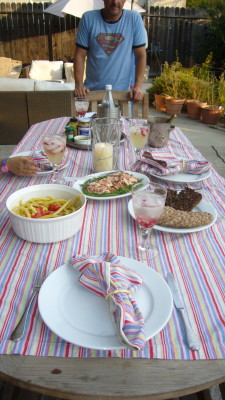
Earlier I had made the bread, which involved pouring hot water into the carton, letting the dough rise, and baking–a job the husband was able to oversee–and set out the crackers.
I found a bar platter for condiments–capers, dijon and yellow mustard, lemons, and a homemade mustard/dill sauce.
I cooked & garnished the salmon.
I tossed a familiar dish with a mustard-based dressing instead of balsamic vinegar.
The result was a meal that looked like a lot of other meals at my house, but was utterly different. The kids immediately proceeded to make “sandwiches” with the crackers, topping them with salmon, capers, lemon, mustard….whatever. They found it unreasonable silly to mix everything up. The thing was, that all the flavors on the table went together, so it didn’t matter what they did–it all tasted good and was good fun in the tasting.
Homemade Mustard Dill Sauce
- Dijon mustard
- Rice or white wine vinegar
- Brown sugar
- Olive oil
- Fresh dill
In a jar with a lid, mix equal parts dijon mustard and white wine vinegar and a teaspoon or so of brown sugar. Then add 2 parts olive oil (so there is twice as much olive oil as mustard/vinegar mix. Add a good handful of chopped dill. Shake and serve.
Yellow Beans and Cherry Tomatoes with Mustard Vinaigrette
- Dijon vinegar
- White balsamic vinegar
- 1 clove garlic
- Olive oil
- Yellow beans
- Cherry tomatoes
Steam or boil yellow beans in well-salted water until tender-crisp. Slice cherry tomatoes in half.
When beans are cool, toss them with the tomatoes in the serving dish.
Make a vinaigrette by mixing equal parts mustard and white balsamic vinegar. Add two parts olive oil (so there is twice as much olive oil as mustard vinegar) and a pinch of salt. Smash a clove of garlic and let it sit in the vinaigrette for as much time as you have.
Toss the salad with the vinaigrette and serve.

